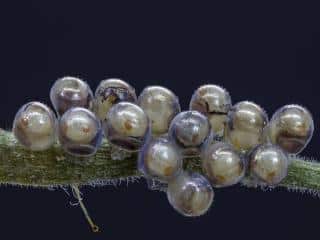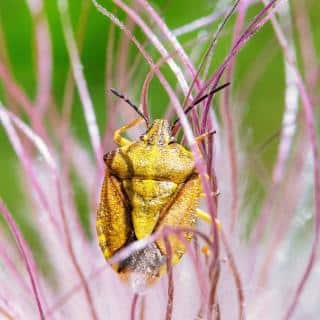

Green, red, or brown, the stink bug feasts on garden vegetables! Discover how to recognize shield bugs and which organic treatments work best against these pests.
→ More to discover:
You’ve certainly come across the stink bug that sometimes nests in homes, leaving a nauseating smell behind. Indeed, the Latin source for its botanical name is putinasius, which means “to smell bad”…
In the garden, several species of shield bugs also do their best to annoy gardeners.
No matter the species, every shield bug consists of a head, thorax, and abdomen. It also has two antennae and two pairs of wings. Three pairs of legs (it’s an insect) let it move on plants and it measures between 0.4 inch and 0.6 inch (between 1cm and 1.5cm).

These sap-sucking insects feed on garden plants, orchard trees, or flowers depending on the species. They stab their mouthpiece through leaves, fruits, and flower buds, and then suck their sap. They weaken the plant and sometimes even cause its death.
The only preventive technique is setting up a bug net that will keep all pests out of a plot or growing bed in the garden.
This decoction reportedly has a repelling effect on stink bugs.
You can store this decoction cool for 10 days. To use it, simply spray it on the affected plants.
Some gardeners recommend wormwood fermented tea. To make it yourself, nothing could be easier!
 Fill a non-metal container with about 2.5 gallons of rainwater or filtered water (10 liters).
Fill a non-metal container with about 2.5 gallons of rainwater or filtered water (10 liters).To use it, you’ll need to dilute it to 10% in water. For instance, use about 3.5 fluid ounces of wormwood concoction per quart of water), or 100 ml of preparation for 1 liter water.
Mint, like wormwood, reportedly repels bugs. This means you can make another mixture, this time based on mint essential oil.
Simply add 5 drops of mint essential oil in around 1 cup of boiling water (250ml). Let it cool and spray this solution on your bug-infested plants. You can try plant mint near your crops as a companion plant, but this technique might be less concentrated, less targeted, and therefore less effective.
Experienced gardeners often mention it as an excellent bug repellent.